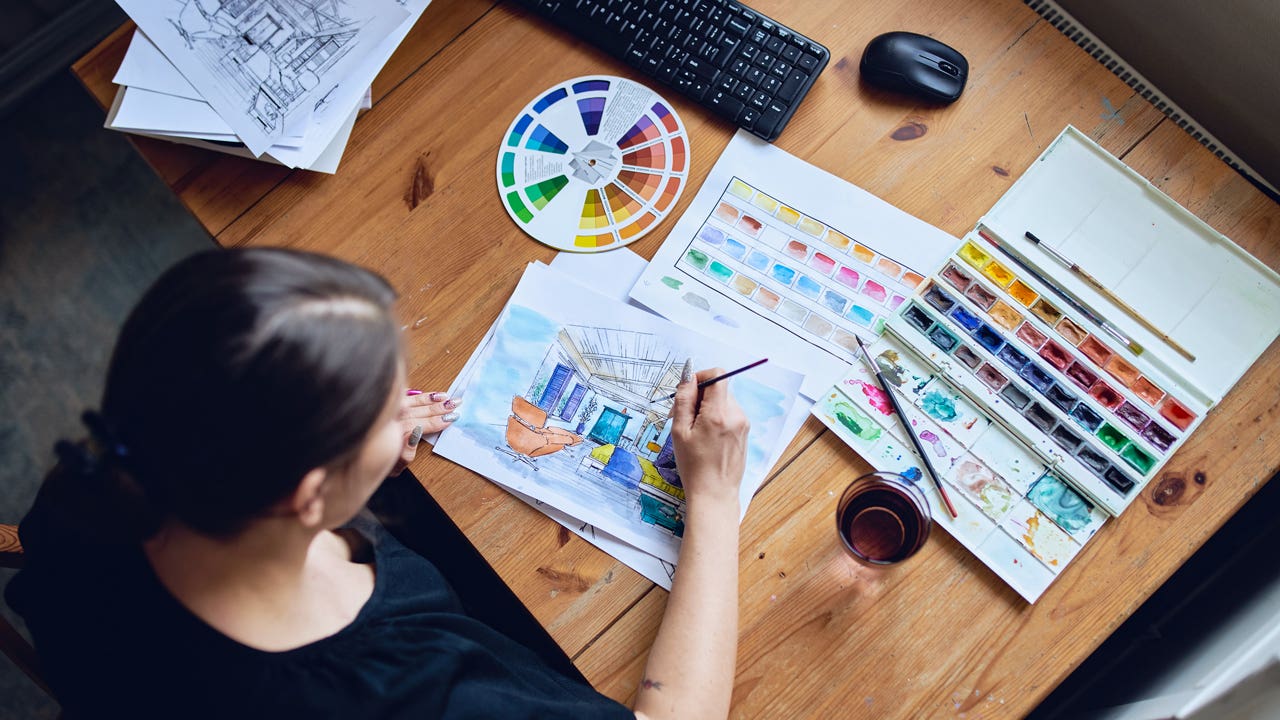How freelance artists can manage their money

Freelance artists are self-employed, and they often work with multiple clients concurrently on projects that can include illustration, graphic design, photography or interior design. Their clients may include book authors or publishers, video or board game developers or film companies. Freelance artists commonly work remotely — and some create their art digitally, emailing it to clients for review and approval.
Earning a living as an artist these days is more attainable than ever, thanks to social media — yet having a lucrative art career might still be difficult, especially for those just starting out. Being successful as a freelancer requires strong money management skills, including budgeting your money and having enough funds in savings to cover periods when business may be slow.
Key statistics for freelance artists:
The average annual salary for all types of freelancers in the U.S. is $68,549, which is around $17,000 more than what freelancers who are artists earn per year on average, according to data from ZipRecruiter. The jobs website lists openings for artists that include graphic artists, technical artists, 3D artists and mechanical artists.
Here are some 2022 key statistics regarding artists who freelance, sourced from ZipRecruiter, Talent.com and Zippia:
- Average salary for a freelance artist: $51,237
- Average salary for entry-level freelance artist: $40,950
- Percentage of employees in creative fields who are freelancers: 75 percent
- Percentage of freelance artist designers who are men: 51 percent
- Percentage of freelance artist designers who are women: 49 percent
- Average age of freelance artist designer: 37 years old
- Location of majority of freelance artist designers: New York, Los Angeles
When it comes to race, more than three-quarters of freelance artist designers are White, while Latinos, Asians and Blacks make up less than 10 percent each of this type of freelancers — according to job-finding website Zippia. It reports Asian American freelance artist designers earn the highest average annual income ($56,787), while those who are Black or African American earn the lowest average annual income ($50,692).
Of the 59 million people in the U.S. who do freelance work in general, 21 million — or 36 percent — do this work on a full-time, long-term basis, according to Zippia.
Average freelance artist salary, per field
Average salaries can vary among the various artistic freelance fields, with illustrators — the top-earning field on the list — earning an average of over $8,000 more than the lowest-earning role of painter.
| Career | Average annual salary |
|---|---|
| Illustrator | $61,544 |
| Digital artist | $60,161 |
| Interior designer | $58,744 |
| Makeup artist | $55,591 |
| Photographer | $54,971 |
| Painter | $53,124 |
Source: ZipRecruiter (2022)
In addition to the artistic field, where freelance artists live can affect how much money they earn. For instance, the average salary is highest in the states of Washington and Maryland, while those in Louisiana and North Carolina earn the least per year, on average.
Ways for artists to advance their income
Bachelor’s degree
If you’re a freelance artist looking to make more money, there are various steps you can take, such as furthering your education. More than half — 59 percent — of artists hold a Bachelor’s degree, according to Zippia. Degrees in fine arts programs often allow you to specialize in fields such as animation, film, painting, drawing, photography and graphic design.
Certification
While it may not be required, certification is another way for artists to show proof of skills and knowledge in a particular art field. Examples of certifications include ones in art education, art therapy or forensic art. An exam may be one of the requirements to obtain a certification.
Business classes
Artists and other freelancers who are self-employed might consider taking some business or personal finance classes — whether they count toward a degree or aren’t taken for credit. Such courses may help freelancers learn about filing taxes, generating invoices, budgeting money, and reinvesting in one’s business.
Commissioned artwork
Commissioning is when a client hires an artist to create a piece of artwork. As an artist, you can negotiate the commission amount and payment structure with the client, with the artist commonly requesting half the payment up front and the other half upon completion. Artists may seek out commissions by posting photos of their work on social media — with a mention in the bio that they accept commissions — or through platforms such as Artfinder or ArtCorgi.
Online marketplaces
Artists often look to online marketplaces like Etsy, Sellfy and Redbubble to earn passive income by selling their wares, such as paintings, jewelry, furniture or digital art. These platforms connect buyers with sellers and can be a good resource for artists who are starting out and looking to build up a clientele.
Teaching others about art
Some artists make money — and gain some teaching experience — by offering art classes in person or online. Teaching skills such as painting, photography, sculpting or pottery can be done at private parties, corporate events, or your local library or community center. The benefits of teaching others about art can include both earning money and creating projects you love.
Why financial literacy is crucial for an art career
Inconsistent income
Many freelancers experience an income that fluctuates from month to month, which can be caused by projects ending or reduced hours for an ongoing job. You can help plan for periods when you’ll earn less money by building up savings in advance.
Find extra money to set aside by creating a work budget that lists your operating expenses as well as your estimated monthly income for the near future. Likewise, create a personal budget that lists things like housing, food, transportation and entertainment. Aim to set aside money for your living expenses as well as for building up your savings. Budgeting apps can help simplify the process of money management.
Low starting salary
It can take a significant amount of time for new artists to build up a client list, which makes strong money management skills more important than ever. The average starting salary for freelance artists is $40,950, according to Talent.com, and you’ll need to pay yourself an income as well as fund any business expenses. Those who are just starting out may decide to take on a full-time job to receive a steady income as they build up their freelance business. Others create multiple income streams such as selling work through Etsy or another online marketplace.
Emergency funding
Having money set aside for emergencies is important whether you’re a freelancer or a salaried employee. Experts recommend that those with a variable income should set aside nine to 12 months’ worth of living expenses for emergencies. Having this extra money in the bank can help get you through months when work is slow.
Planning for retirement
Without access to an employer-sponsored 401(k) plan, freelancers need to find other ways to fund their retirement. A traditional IRA allows you to make tax-deductible contributions, while a Roth IRA allows for after-tax contributions and money that grows tax-free. Traditional and Roth IRAs can be set up with many banks, credit unions and brokerages.
Funding your art
A self-employed artist often needs to fund everything from new supplies to marketing initiatives to work-related travel. These expenses should be factored into your work budget so you can set aside money for them.
Some artists apply for grants that are offered from corporations, individuals and nonprofit or philanthropic entities. Organizations that offer artistic grants include ArtistGrant.org, Artadia and the New York Foundation for the Arts.
Artistic focus
One’s creativity can be negatively impacted by a fluctuating income and not having much money set aside for emergencies or retirement. Good money management skills help you avoid stress and maintain peace of mind by keeping you economically stable.
How to manage finances as an artist
Set financial goals
Setting financial goals and continually working toward them can help you have a long-term, flourishing artistic career. Decide what you want to save for — whether it’s traveling, opening an art studio or retiring early — and set aside money every month for those goals. Monitor and adjust your financial goals, as they may change as your income or work situation changes.
Make a personal budget
Having a personal budget allows you to know, with some accuracy, how much money comes in and goes out every month. In addition to living expenses, funds in your monthly budget should be devoted to saving money, whenever possible. Having a budget can benefit those on a fluctuating income since it may help you to build up savings for a rainy day.
Open a high-yield savings account
Some high-yield savings accounts currently pay up to seven times the national average, so it pays to shop around for the best rates — which often can be found at online banks. Earning a competitive rate can ensure your money is growing, even if you make small — yet consistent — deposits over time. You might also earn a bank account bonus for opening a checking or savings account with some banks.
Automate payments
Having your monthly bills automatically charged to your credit card or debited from your bank account can ensure they’re paid by their due dates — giving you more time and energy for creating art and managing other aspects of your business.
Review your finances
Taking a look regularly at your bills helps make sure you aren’t getting charged for anything more than you should. Likewise, review your bank statements and credit report to ensure everything is in order and help you detect any fraud or information that’s inaccurate.
Avoid debt
Staying out of debt is often crucial to building up savings. If you’re carrying a balance on a credit card with a comparatively high interest rate, consider making a balance transfer to one with a lower rate. If you have an adequate emergency fund, it could be worth your while to use any additional savings to pay off credit card debt that’s racking up interest.
Those with student loan debt can reduce the overall interest accrued and pay the loan off sooner by paying more than the minimum amount each month.
Start investing
Long-term investing can provide you with financial security and peace of mind. It can be a way to build wealth and outpace inflation, which may help you maintain quality of life and make better decisions throughout your career. Places you can invest your money include index funds, mutual funds and exchange-traded funds. Taking the time to learn investment basics can help you make the right choices to grow your wealth.
Shop smart
When shopping for things you need, it pays to take the time to find deals and sales, and to use coupons when possible. Stick to a budget, and hold off on buying certain things until it’s the best time of year. For instance, January is often the best time of year to purchase exercise equipment, while you may find the best deals on mattresses in July.
Eliminate unnecessary expenses
When it comes to buying everything from art supplies to groceries, consider whether you really need items before buying them. You also may be incurring credit card charges for things you no longer use, such as streaming services or other memberships. Review your statements regularly, and consider a mobile app that helps you manage your subscriptions, some of which can even cancel unwanted subscriptions automatically on your behalf.
Emergency relief grants
Nonprofit organizations such as Craft Emergency Relief Fund and The Adolph & Esther Gottlieb Emergency Grant provide financial support to artists in need. Artists who may qualify include those who have experienced events such as fire, flood, theft or a medical emergency.
Bottom line
Starting and maintaining a career as an artist can be challenging from a financial standpoint, since building up a clientele often takes time, and income can fluctuate greatly. However, it’s possible to have a successful career through financial literacy and smart business skills. With the proper skills, artists can navigate the highs and lows of the art business world, and even thrive through savings and investments.
Why we ask for feedback Your feedback helps us improve our content and services. It takes less than a minute to complete.
Your responses are anonymous and will only be used for improving our website.
You may also like

Dollars and Debts With Denny: The art of the side hustle





